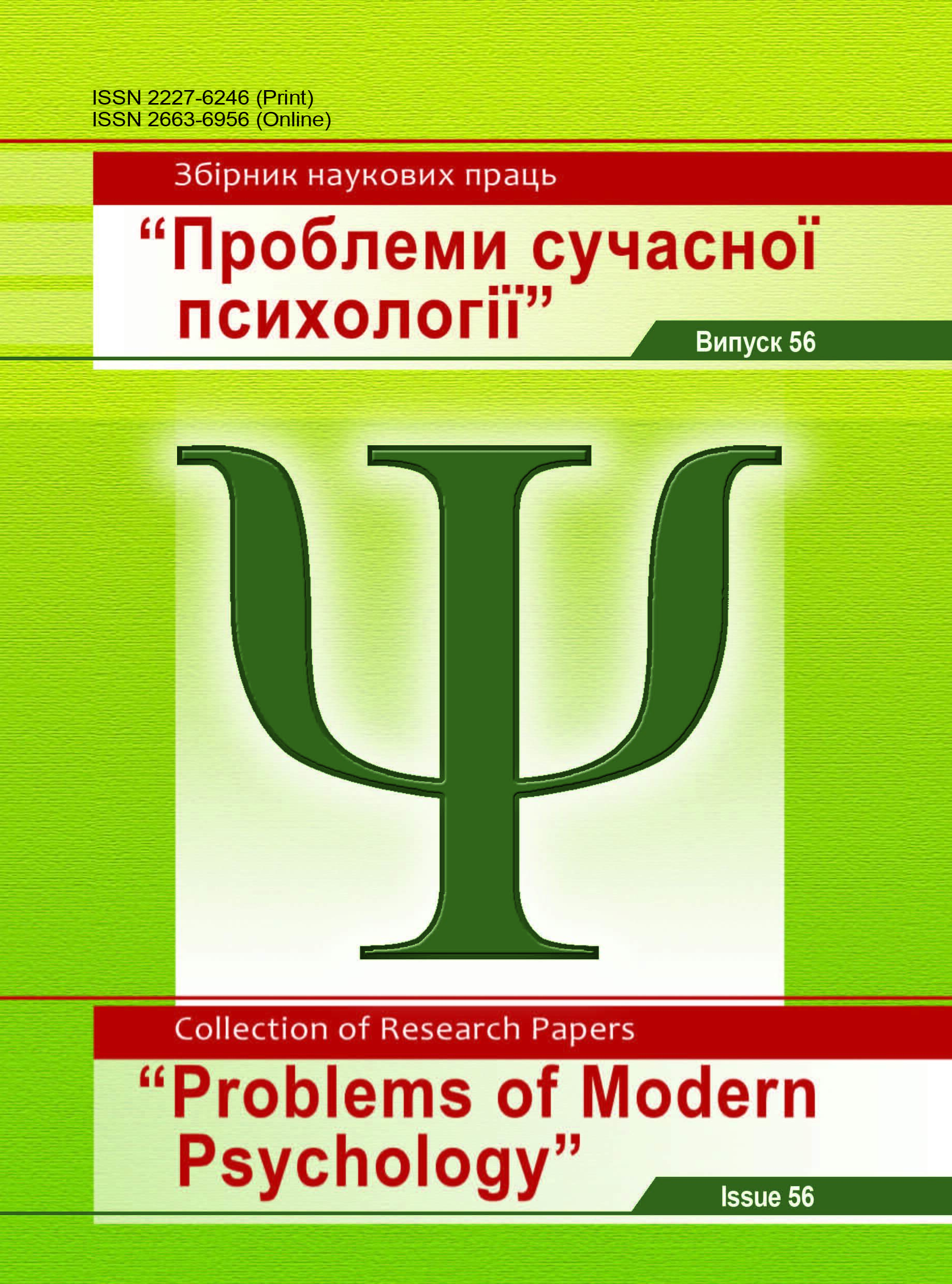Characteristics of Using Video-Phonograms in Teaching Teenagers Foreign Languages at Secondary Schools
DOI:
https://doi.org/10.32626/2227-6246.2022-56.108-128Keywords:
psychological characteristics of using video-phonograms, reflection, thinking, a direct contact with a listener, the syntagmatic reorganization of the text, non-textual associations, dialogical quasi-communication with the textAbstract
The purpose of our research is: to determine psychological characteristics of using video-phonograms in teaching pupils foreign languages at secondary schools; to build a model of educational process with using video-phonograms; to show the characteristics and tasks of each sub-cycle of a video-phonogram; to describe this model in the stage of its experimental verification.
Methods of the research. The following theoretical methods of the research were used to solve the tasks formulated in the article: a categorical method, structural and functional methods, the methods of the analysis, systematization, modeling, generalization. The experimental methods are observation and analysis. The participants of our research were 45 pupils of the 7th-B form of school №15 of Rivne (Ukraine). The experiment lasted during 2020-2021 years.
The results of the research. Based on the theory of a dialogue in a paradigm of Secondary Predication (Mykhalchuk & Ivashkevych, 2019), we define the following main characteristics of the concept of “a dialogic text” which is the basis of video-phonograms in teaching teenagers the foreign languages at secondary schools: 1) an attempt to include the listener into a joint search with the author of the truth, focus on the reflection and thinking; 2) the author’s desire to make direct contact with a listener, which is expressed in the variability of the material for analysis and understanding, the possibility of providing a creative approach to understanding the content, because only personal involvement of the listener makes the text a work of art.
Conclusions. It is emphasized that any video-phonogram has a triple meaning: 1) a primary or common meaning; 2) a secondary one – which arises due to the syntagmatic reorganization of the text and the opposition of the primary units; 3) tertiary meaning, which is based on non-textual associations of different levels – from the most general to purely personal, authorial ones (they are fixed at the level of authorial paradigms or the author’s dictionary).
Therefore, we define the text of a video-phonogram as an extremely complex phenomenon, which emphasizes the impossibility of comprehensive delineation of textual parameters, all components of its content. This, in turn, somewhat prevents the listener from fully understanding the richness and diversity of the meaning of a video-phonogram. It was proved that the semantic structure of the text changed from a reader to reader. And nothing is able, even the development of science, to stop the movement of the text, to master all its semantic richness, because the text is infinitely open to infinity, and the constants of individual style create the openness of the video-phonogram, the possibility of a listener entering the process of dialogical quasi-communication with the text.
References
Aleksandrov, A.A., Memetova, K.S., & Stankevich, L.N. (2020). Referent’s Lexical Frequency Predicts Mismatch Negativity Responses to New Words Following Semantic Training. Journal of Psycholinguistic Research, 49, 187-198. Retrieved from https://doi.org/10.1007/s10936-019-09678-3.
Charles, W. (2000). Contextual correlates of meaning. Applied Psycholinguistics, 21(4), 505-524. Retrieved from https://doi.org/10.1017/S0142716400004057.
Honcharuk, Nataliia, & Onufriieva, Liana (2018). Psykholohichnyi analiz rivniv pobudovy komunikatyvnykh dii [Psychological analysis of the levels of construction of communicative actions]. Psycholinguistics. Psykholinhvistyka. Psikholingvistika - Psycholinguistics. Psycholinguistics. Psycholinguistics, 24(1), 97-117. Retrieved from https://doi.org/10.31470/2309-1797-2018-24-1-97-117 [in Ukrainian].
Ivashkevych, Er., & Komarnitska, L. (2020). Psychological aspects of comics as the paraliterary genres. Zbirnyk naukovykh prats «Prob- lemy suchasnoi psykholohii» - Collection of research papers “Problems of modern psychology", 49, 106-130. Retrieved from https://doi.org/10.32626/2227-6246.2020-49.106-130.
Maksymenko, S., Tkach, B., Lytvynchuk, L., & Onufriieva, L. (2019). Neiropsykholinhvistychne doslidzhennia politychnykh hasel iz zovnishnoi reklamy - A neuropsycholinguistic research of political slogans from outdoor advertising. Psycholinguistics. Psykholinhvistyka. Psikholingvistika - Psycholinguistics. Psycholinguistics. Psycholinguistics, 26 (1), 246-264 [in Ukrainian].
Mykhalchuk, N., & Bihunova, S. (2019). The verbalization of the concept of “fear” in English and Ukrainian phraseological units. Cognitive Studies | Études cognitives, Warsaw (Poland), 11. Retrieved from https://doi.org/10.11649/cs.2043.
Mykhalchuk, N., & Ivashkevych, Er. (2019). Psycholinguistic Characteristics of Secondary Predication in Determining the Construction of a Peculiar Picture of the World of a Reader. Psycholinguistics. Psykholinhvistyka. Psikholingvistika - Psycholinguistics. Psycholinguistics. Psycholinguistics, 25(1), 215-231. Retrieved from https://doi.org/10.31470/2309-1797-2019-25-1-215-231.
Mykhalchuk, Nataliia, & Khupavsheva, Natalia (2020). Facilitation of the Understanding of Novels by Senior Pupils as a Problem of Psycholinguistics. Psycholinguistics. Psykholinhvistyka. Psikholingvistika - Psycholinguistics. Psycholinguistics. Psycholinguistics, 28(1), 214–238. Retrieved from https://doi.org/10.31470/2309-1797-2020-28-1-214-238
Downloads
Published
How to Cite
Issue
Section
License
Copyright (c) 2022 Mykhalchuk Nataliia, Koval Iryna

This work is licensed under a Creative Commons Attribution-NonCommercial 4.0 International License.
Copyright
The Editorial Board has the full right to publish original scientific papers containing results of theoretical and experimental research works which are not currently subject to review for publication in other scientific editions. The Author shall transfer to the editorial board of the Collection the right to spread the electronic version of the paper, as well as the electronic version of the paper translated into English (for papers originally submitted in Ukrainian and Russian) by all kinds of electronic means (placement at the official website of the Collection, electronic databases, repositories etc).
The Author of an article reserves the right to use materials of the paper, without approval with the editorial board and the founders of this Collection: a) partially or fully, for educational purposes; b) for writing own dissertation papers; c) for preparation of abstracts, conference reports and presentations.
The Author of an article can place electronic copies of the paper (including the final electronic version downloaded from the official website of the Collection) at:
- personal web resources of all Authors (websites, webpages, blogs etc.);
- web resources of the institutions where the Authors are employed (including electronic institutional repositories);
- non-profit public access web resources (for example, arXiv.org).
But in all cases, it is obligatory to have a bibliographic reference to the paper, or a hyperlink to its electronic copy placed at the official website of this Collection.







